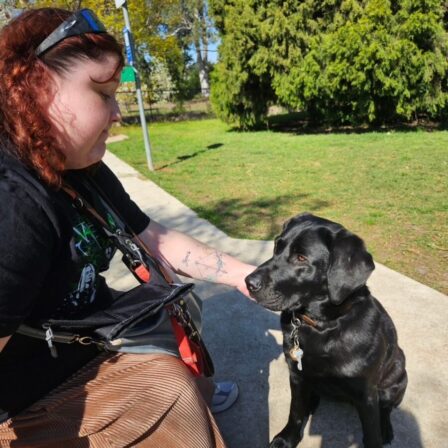News
Guide Dogs call for public to “Clear the Way” for more inclusive communities
- Physical and social barriers affect 4 in 5 living with blindness and low vision.
- 96% have experienced footpath obstructions in the last two years.
- Overhanging trees (63%), construction works (55%) and e-scooters (49%) biggest obstacles.
Guide Dogs Australia is calling for community help to ‘Clear the Way’ of physical and social barriers to inclusion as new research reveals the majority of people living with blindness and low vision face daily public exclusion.
The Guide Dogs Australia commissioned Ernst & Young report surveyed 622 people with low vision or blindness to understand inclusion barriers. It found over 80% faced regular challenges in public that significantly impacted their confidence and participation in society, ranging from physical barriers on footpaths to inaccessible workplaces and voting stations.
In response, this International White Cane Day (IWCD) October 15, Guide Dogs Australia is asking the community to help “Clear the Way” by removing obstructions to pathways and access points and being more conscious of how actions impact accessibility.
The annual IWCD is dedicated to raising awareness of the daily access challenges faced by the more than 575,000 Australians with low vision or blindness.
Jamal Abdul aged 30 is a Guide Dogs Client who uses a white cane “physical barriers or non-inclusive design in public can make it really difficult and dangerous for those living with low vision and blindness to navigate spaces.
“The path obstacle I commonly experience is outdoor seating at restaurants or cafes, especially in warmer weather. I would just ask that businesses and people be more mindful about where chairs are left, how far out they sit, or crowding around ordering and queuing because it can make it much harder to navigate.”
“For me the lack of tactile surfaces in public is also a major barrier because those are so crucial to help indicate simple things for people who use white canes including when stairs are coming or when I am at the edge of a busy road. E-bikes and scooters are also currently really popular but when they get dumped in the middle of path, they can be tricky to get around and slow me down.”
The research found that 96% of people with low vision or blindness had recently experienced blocked footpaths with obstacles such as e-scooters, e-bikes, shared paths and crowd protection barriers emerging as new issues this year. Other common public obstructions included:
- Overhanging branches reported as the most problematic obstruction (63%)
- New road works including Telstra pits or poor barricading (55%)
- E-scooter and bikes (49%)
- Shared paths, Café/restaurant outdoor tables and chairs (46%)
- Shop displays (44%)
- Parked cars (43%)
- Rubbish bins (33%)
Roads without a kerb or ramp are also a dangerous obstacle when travelling, alarmingly only one in five feel really confident to cross when the footpath and the road are at the same level.
In addition to obstacles, issues with public transport have seen limited change from previous research conducted over ten years ago. The main challenge with buses is the lack of announcements resulting in people not knowing when to get off (20%) and problems with boarding and alighting trains (22%).
In terms of public destinations, a third of respondents cited the inability to access menus or layouts at cafés and restaurants as the most problematic challenge, followed by pubs and supermarkets as difficult to navigate (28%) and workplaces due to lack of flexible working arrangements to suit needs (23%). Shockingly over half respondents (53%) felt security guards had a lack of knowledge about people with low vision and blindness, creating another social barrier.
Guide Dogs New South Wales Chief Executive Officer, Dale Cleaver said “The theme for this year’s international White Cane Day is ‘Clear the Way’ because we are really imploring the community to address the barriers that those living with low vision and blindness encounter daily.”
“People who use white canes are proficient and skilled at navigating their community; however, this research highlights the challenges posed by everyday obstacles that sighted people might not think about. These can be as simple as an e-bike left in the middle of the pavement or a café with lots of chairs in the way.”
“While the majority of Australians do the right thing, it is important for us all to bear in mind the actions we can take to enhance access for people with blindness and low vision. From businesses to frontline works and transports staff, we can help keep everyone safe by ensuring we Clear the Way and being more conscious of the accessibility rights of this community.”





